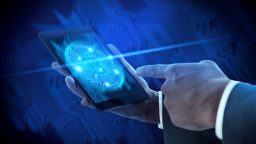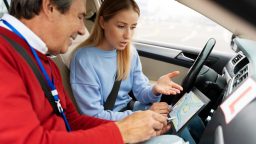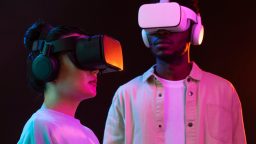In the world of education, one of the biggest challenges has always been finding ways to engage students and ensure that learning is not only effective but also memorable. Traditional teaching methods often struggle to captivate today’s tech-savvy students, and educators are constantly looking for innovative ways to enhance learning. That’s where Virtual Reality (VR) and Augmented Reality (AR) come in. These technologies are revolutionising how we learn by offering immersive and interactive experiences that go beyond traditional classroom settings.
In this article, we’ll explore how VR and AR are enhancing learning experiences across various fields, from primary schools to universities and even corporate training.
- Immersive Learning with Virtual Reality (VR)
Virtual Reality takes students into a completely digital world, creating a fully immersive experience that can transport them to any place, time, or environment. VR learning environments can simulate real-life situations, allowing students to experience and interact with the subject matter in ways that textbooks or videos simply cannot achieve.
For example, in science education, students can take virtual field trips to faraway places, like walking on the surface of Mars, exploring the human circulatory system from within, or swimming with marine life in the ocean. By engaging with these virtual environments, students gain a deeper understanding of the subject, making abstract concepts more tangible.
In medical training, VR simulations are used to help students practice surgeries or diagnose diseases without the risk of harming real patients. Medical students can perform complex procedures in a controlled, virtual environment, building their skills and confidence before working with real patients.
- Augmented Reality (AR): Bringing Learning to Life
While VR creates entirely virtual worlds, Augmented Reality (AR) overlays digital information onto the real world, blending the physical and digital realms. This allows students to interact with both the tangible and virtual elements simultaneously, enhancing their learning experience.
One of the most common uses of AR in education is through mobile apps, where students can scan images, books, or even classroom objects to reveal interactive, 3D models. For example, when studying the human anatomy, students can use an AR app to point their devices at a textbook or diagram, and it will display a 3D model of the human body. This lets them rotate and zoom in on different organs and systems, making learning more interactive and engaging.
AR is also being used to enhance the learning of historical events. Imagine studying the Ancient Roman Empire and pointing your tablet at a classroom wall, only to see a 3D recreation of the Colosseum rise up before you. This helps students better understand historical events, architecture, and cultures by bringing the past into the present.
- VR and AR in STEM Education
STEM (Science, Technology, Engineering, and Mathematics) education has greatly benefited from VR and AR technologies, as these fields often involve complex, abstract concepts that are hard to grasp through traditional teaching methods. Both VR and AR make learning in STEM more interactive, engaging, and effective.
In engineering, VR can simulate the construction of complex machines or buildings, allowing students to virtually assemble and disassemble various components. Students can also explore how different materials behave under specific conditions, such as testing the strength of a material in virtual environments.
For technology and computer science students, AR can be used to teach coding, software development, and system architecture. AR apps allow learners to interact with and manipulate virtual coding environments, helping them understand how different software components work together in real time.
- Virtual Field Trips: Exploring the World from the Classroom
Field trips have always been a popular way for students to learn through experience. However, logistical and financial constraints often make it difficult to organise these trips. VR offers a solution by allowing students to take virtual field trips to places they might never be able to visit in person.
For example, students can „travel” to historical landmarks like the Great Wall of China, visit natural wonders like the Amazon rainforest, or explore famous museums without leaving the classroom. This immersive experience provides them with an in-depth understanding of different places, cultures, and historical events, expanding their global perspective.
VR also gives students access to experiences that would be impossible or unsafe in real life. For instance, students can explore the inside of a volcano, simulate a space mission, or take part in historical battles. These virtual adventures provide unparalleled opportunities for experiential learning.
- Enhancing Collaborative Learning with AR and VR
Both VR and AR are not only great for individual learning but also for collaborative learning experiences. With VR, students can interact with each other in a shared virtual space, no matter where they are located. This opens up new possibilities for group projects, collaborative problem-solving, and even virtual classrooms that connect students from around the world.
For instance, in a VR classroom, students might gather together in a virtual space to work on a group project, interacting with 3D models or simulations. They can brainstorm ideas, manipulate objects, and work together on complex problems in real time, all while engaging in a social and immersive experience.
Similarly, AR can enhance collaborative learning by allowing students to share their devices and work together in augmented environments. In a biology class, for example, students could collectively explore the anatomy of a plant, each using their own device to interact with different parts of the model and share their findings with the group.
- VR and AR in Corporate Training
The use of VR and AR isn’t limited to the classroom. These technologies are also transforming corporate training and development. Companies are increasingly turning to VR to provide employees with realistic, risk-free environments to practice their skills.
For example, VR simulations are used in fields like aviation, healthcare, and emergency services to train employees for real-life situations. Pilots can practice flying in adverse weather conditions, medical professionals can rehearse complex surgeries, and firefighters can experience emergency scenarios—all without the need for physical equipment or risking human lives.
AR is also being used to train employees in fields such as manufacturing and retail. By using AR glasses or mobile devices, workers can receive real-time instructions and guidance while performing tasks. This reduces training time and increases accuracy, as employees can follow step-by-step instructions without needing to reference manuals or ask for help.
- The Future of AR and VR in Education
As AR and VR technologies continue to evolve, the future of learning looks even more exciting. Advances in haptic feedback, eye-tracking, and AI integration are likely to create even more immersive and personalised learning experiences. Imagine learning about chemistry through a fully interactive lab where you can „feel” the reactions, or studying a foreign language by having live conversations with virtual native speakers.
The development of more affordable and accessible AR and VR devices will also make these technologies available to a wider audience, enabling schools and universities to implement these tools into their curriculums more easily.
Conclusion: A New Era of Learning
Virtual Reality and Augmented Reality are no longer just futuristic concepts—they are transforming the educational experience right now. By providing immersive, interactive, and hands-on learning opportunities, these technologies engage students in ways that traditional teaching methods simply can’t. From virtual field trips to real-time, collaborative learning, VR and AR are making education more exciting, accessible, and effective than ever before. As these technologies continue to improve and become more widespread, they will undoubtedly shape the future of education and enhance learning experiences for generations to come.





